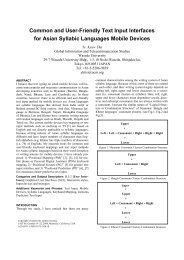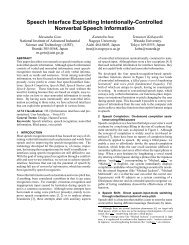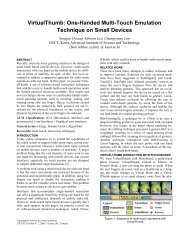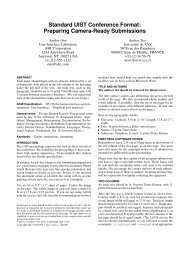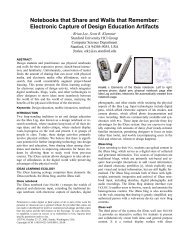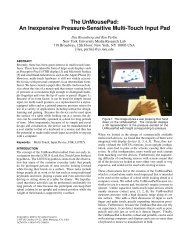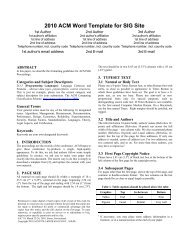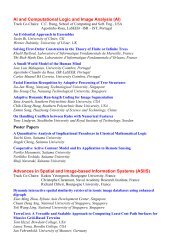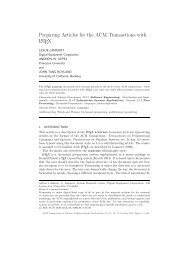API Design Matters Stonebraker and Seltzer - RabbitMQ
API Design Matters Stonebraker and Seltzer - RabbitMQ
API Design Matters Stonebraker and Seltzer - RabbitMQ
Create successful ePaper yourself
Turn your PDF publications into a flip-book with our unique Google optimized e-Paper software.
the lists in sorted order so it can use a split search (which<br />
is more work). This is a good example of how design flaws<br />
have a tendency to spread <strong>and</strong> cause collateral damage:<br />
an oversight in one <strong>API</strong> causes grief in an unrelated <strong>API</strong>.<br />
I will spare you the details of how to complete the<br />
wrapper code. Suffice it to say that the supposedly simple<br />
wrapper I set out to write, by the time I had added parameter<br />
copying, error h<strong>and</strong>ling, <strong>and</strong> a few comments, ran to<br />
nearly 100 lines of fairly complex code. All this because of<br />
a few seemingly minor design flaws:<br />
• Select() overwrites its arguments.<br />
• Select() does not provide a simple indicator that would<br />
allow the caller to distinguish a return because of a<br />
time-out from a return because a socket is ready.<br />
• Select() does not allow a time-out longer than 35 minutes.<br />
• Select() uses lists instead of sets of sockets.<br />
Here is what Select() could look like instead:<br />
public static int<br />
Select(ISet checkRead, ISet checkWrite,<br />
Timespan seconds,<br />
out ISet readable, out ISet writeable,<br />
out ISet error);<br />
With this version, the caller provides sets to monitor<br />
sockets for reading <strong>and</strong> writing, but no error set: sockets<br />
in both the read set <strong>and</strong> the write set are automatically<br />
monitored for errors. The time-out is provided as a<br />
Timespan (a type provided by .NET) that has resolution<br />
down to 100 nanoseconds, a range of more than 10 million<br />
days, <strong>and</strong> can be negative (or null) to cover the “wait<br />
forever” case. Instead of overwriting its arguments, this<br />
version returns the sockets that are ready for reading,<br />
writing, <strong>and</strong> have encountered an error as separate sets,<br />
<strong>and</strong> it returns the number of sockets that are ready or<br />
zero, in which case the call returned because the time-out<br />
was reached. With this simple change, the usability problems<br />
disappear <strong>and</strong>, because the caller no longer needs to<br />
copy the arguments, the code is far more efficient as well.<br />
There are many other ways to fix the problems with<br />
Select() (such as the approach used by epoll()). The point<br />
of this example is not to come up with the ultimate version<br />
of Select(), but to demonstrate how a small number<br />
of minor oversights can quickly add up to create code<br />
that is messy, hard to maintain, error prone, <strong>and</strong> inefficient.<br />
With a slightly better interface to Select(), none of<br />
the code I outlined here would be necessary, <strong>and</strong> I (<strong>and</strong><br />
probably many other programmers) would have saved<br />
considerable time <strong>and</strong> effort.<br />
more queue: www.acmqueue.com<br />
THE CosT of Poor <strong>API</strong>s<br />
The consequences of poor <strong>API</strong> design are numerous <strong>and</strong><br />
serious. Poor <strong>API</strong>s are difficult to program with <strong>and</strong> often<br />
require additional code to be written, as in the preceding<br />
example. If nothing else, this additional code makes<br />
programs larger <strong>and</strong> less efficient because each line of<br />
unnecessary code increases working set size <strong>and</strong> reduces<br />
CPU cache hits. Moreover, as in the preceding example,<br />
poor design can lead to inherently inefficient code by<br />
forcing unnecessary data copies. (Another popular design<br />
flaw—namely, throwing exceptions for expected outcomes—also<br />
causes inefficiencies because catching <strong>and</strong><br />
h<strong>and</strong>ling exceptions is almost always slower than testing<br />
a return value.)<br />
The effects of poor <strong>API</strong>s, however, go far beyond inefficient<br />
code: poor <strong>API</strong>s are harder to underst<strong>and</strong> <strong>and</strong> more<br />
difficult to work with than good ones. In other words,<br />
programmers take longer to write code against poor<br />
<strong>API</strong>s than against good ones, so poor <strong>API</strong>s directly lead<br />
to increased development cost. Poor <strong>API</strong>s often require<br />
not only extra code, but also more complex code that<br />
provides more places where bugs can hide. The cost is<br />
increased testing effort <strong>and</strong> increased likelihood for bugs<br />
to go undetected until the software is deployed in the<br />
field, when the cost of fixing bugs is highest.<br />
Much of software development is about creating<br />
abstractions, <strong>and</strong> <strong>API</strong>s are the visible interfaces to these<br />
abstractions. Abstractions reduce complexity because they<br />
throw away irrelevant detail <strong>and</strong> retain only the information<br />
that is necessary for a particular job. Abstractions do<br />
not exist in isolation; rather, we layer abstractions on top<br />
of each other. Application code calls higher-level libraries<br />
that, in turn, are often implemented by calling on the<br />
services provided by lower-level libraries that, in turn, call<br />
on the services provided by the system call interface of an<br />
operating system. This hierarchy of abstraction layers is<br />
an immensely powerful <strong>and</strong> useful concept. Without it,<br />
software as we know it could not exist because programmers<br />
would be completely overwhelmed by complexity.<br />
The lower in the abstraction hierarchy an <strong>API</strong> defect<br />
occurs, the more serious are the consequences. If I<br />
mis-design a function in my own code, the only person<br />
affected is me, because I am the only caller of the<br />
function. If I mis-design a function in one of our project<br />
libraries, potentially all of my colleagues suffer. If<br />
I mis-design a function in a widely published library,<br />
potentially tens of thous<strong>and</strong>s of programmers suffer.<br />
Of course, end users also suffer. The suffering can take<br />
many forms, but the cumulative cost is invariably high.<br />
For example, if Microsoft Word contains a bug that causes<br />
ACM QUEUE May/June 2007 29




